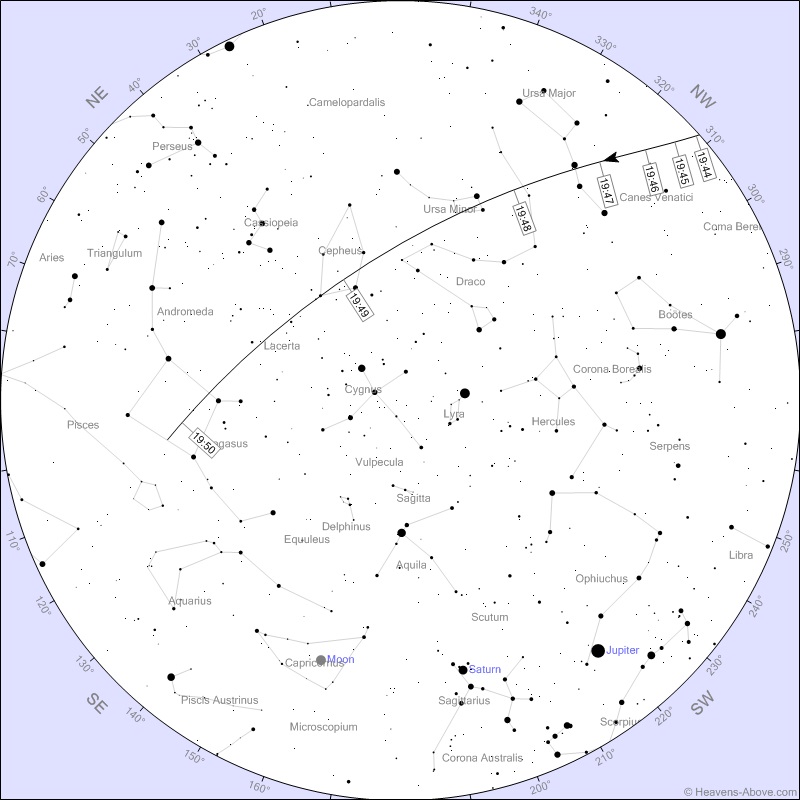Have you ever seen the International Space Station? On a favorable pass overhead, the ISS can outshine all stars and planets in the sky, shining as a brilliant starlike object resembling a slowly moving airplane. Although hard to track because it is moving, you may be able to make out the cross shape of the solar panels with good binoculars or a small telescope.
Put into space and built primarily by astronauts using the Space Shuttle and Russian Soyuz spacecraft between 1998 and 2011, the ISS is far and away the largest man made structure ever built in space, measuring 167’ long and 357’ wide. The ISS is normally occupied by six astronauts and circles 250 miles above the Earth, taking about an hour and a half to complete one orbit.
Although the ISS orbits so often, it must be lit by the Sun to be seen, and pass overhead close enough to your location to rise above the horizon. Thus it is not visible from any one spot on most orbits. The closer to overhead the ISS passes, the closer to you it is, and the brighter it appears. The Station is generally seen either in the early evening within a few hours after sunset, or in the morning before sunrise. This October will be a good time to see the ISS, with an evening series of passes visible from St. Louis Oct. 2-12.
Generally speaking, when seen in the evening, the ISS appears to rise more or less in the northwest sky. It is rather dim at first, but brightens steadily as it rises higher overhead. After reaching its peak, the ISS will seem to fade rapidly into the Earth’s shadow, becoming quite dim or vanishing completely before it goes below the horizon to the south or southeast. Each pass is different, depending upon how close to overhead the Station passes.
Morning passes are understandably much less popular to see than evening ones, and I have only seen a handful over the years. But with daylight savings time still in effect, sunrise comes rather late in October, so many of us will already be getting ready for work or have to get up only a little earlier than normal to see the station almost every morning from Oct. 23- Nov. 1. In some ways morning passes are more dramatic, because the ISS appears to suddenly emerge very brightly from Earth’s shadow, usually in the southeastern sky, and head in a northwesterly direction.
When exactly to look? There are many sources available which announce the ISS’ schedule. I personally prefer Heavens-Above.com or Spotthestation.nasa.gov. I have included a map of the sky for perhaps the very best pass this month. The ISS will be seen at a convenient time of a night, appearing in a dark enough sky and high enough overhead to attain its full brilliance.
On Oct. 7, the ISS will become visible in the northwest around 7:46 pm, depending upon how good your horizon that way is, passing through the Big Dipper and passing above the North Star, high in the northern sky, starting to fade into shadow around 7:50 pm, in the east. (courtesy Heavens Above)

Join us at the Arch for our final Gateway to the Stars program of the year on Saturday evening, Oct. 5. Your Sky Ranger will present our traditional “Ghosts of the Arch Grounds” program at 6:30 pm on the plaza outside the new Arch West Entrance. Historical rather than supernatural in nature, this talk will focus on the “incarnations” of the area as it evolved from a French Fur trading post to a warehouse district to the present Gateway Arch National Park. The adventures and/or misadventures of historic figures like James Eads, Thomas Targee, Kenneth Swyers, Percy Green, and others will be highlighted.
Following the talk, weather permitting, there will be free telescope viewing led by volunteers from the St. Louis Astronomical Society until 8:30 pm. The Moon and the planets Jupiter & Saturn will be seen. Yes, there will be a pass of the International Space Station that night- a medium quality one around 7:49 pm. The “Ghost” talk will take place unless there is rain, however the telescope viewing will be cancelled if skies are too cloudy. Call 314-655-1708 the afternoon of the 5th to check on the weather, or at any time for more information.
